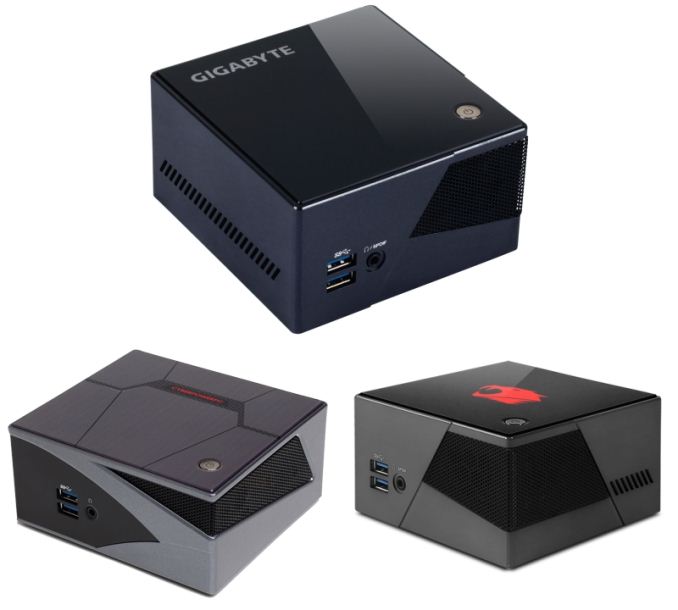GIGABYTE BRIX Pro: A Second Look at the Intel i7-4770R with Iris Pro HD 5200
by Ganesh T S on June 14, 2014 5:00 PM ESTConcluding Remarks
Intel's Core i7-4770R, despite being announced along with the rest of the Haswell family, had been impossible for consumers to source throughout 2013. Earlier this year, GIGABYTE became the first to come out with a PC based on that. The fact that they managed to cram the silicon into a NUC-sized motherboard in the BRIX Pro was no mean engineering feat.
After evaluating the BRIX Pro in detail over the last six months, we can say that it will turn out to be a trendsetter for compact gaming PCs. It has already made boutique PC vendors sit up and take notice. Recently, both iBUYPOWER and CyberPowerPC introduced SFF gaming PCs which use the BRIX Pro and provide consumers with options to complete the build (and create an off-the-shelf solution). In addition, GIGABYTE has already exhibited a number of different configurations in the same form factor.
However, with great power, we end up with much noise too. We simply can't recommend the unit for users who want a quiet HTPC for madVR capabilities or casual office work. But, the unit definitely excels as a compact machine for gaming with medium quality settings. In fact, it comprehensively beats what qualified as a bonafide mini-PC targeting gamers (the ASRock Vision 3D 252B) less than a couple of years ago. The powerful CPU makes sure that extensive multi-tasking as well as heavy duty office work can be carried out without any problems (as long as the acoustics are not a matter of concern). In terms of internal components, it is good to see that the 2.5" drive support is much easier to utilize compared to the Intel D54250WYKH NUC kit. We were a bit worried about the Realtek WLAN solution being foisted on consumers, but it turns out to be a surprisingly good performer (particularly with the Broadcom-based Netgear R7000 in our testbed).
On the whole, the GIGABYTE BRIX Pro has plenty going for it. The only aspect that we would like to see addressed in future versions is the thermal solution. Even while maintaining the same motherboard size, it might be possible to go in for a larger heat sink at the cost of increasing the unit's height. This might allow for better acoustics and extract even better performance from the processor by avoiding the throttling. In our opinion, the target market (gamers) would probably not mind it.











55 Comments
View All Comments
basroil - Sunday, June 15, 2014 - link
Lets put some kinect fusion data in there, this computer is basically begging to be put on a robot!TomWomack - Sunday, June 15, 2014 - link
Do you know of any company planning to release an i7/4770R on a board which can be put into a reasonably-cooled box, rather than in a size-optimised cooling-constrained one?Qwertilot - Sunday, June 15, 2014 - link
No idea. It does sound a bit like Broadwell K should basically do that when it rolls around though.(While presumably performing better too.).
duploxxx - Monday, June 16, 2014 - link
Would really be interested in putting some AMD based solutions next to that, for sure on the very high price of that box.Secondly you clearly see that high res is impossible to play on iris due to the low eDRAM size. so you can say that AMD APU parts really need high speed memory, but you know that the iris pro will never make it for high res even with better memory. so it fails in delivering future.
duploxxx - Monday, June 16, 2014 - link
if you combine a few reviews and look at the Kaveri launch then the 4770R with edram intel part delivers the gpu performance of the same A8-7600 at the same 65W package but probably 3x more expensive... so you don't need to buy this box for gaming, you are better of with the AMD part.JBVertexx - Monday, June 16, 2014 - link
Would like to have seen benchmarks vs. an A10-7850k based build.Hrel - Monday, June 16, 2014 - link
Considering you can make a good gaming rig with a AMD R7 265 for $500 it makes no sense at all to buy a system with an Intel IGP for anything more than $500. Yes, with the Brix platform you get something nicely compact, which is why it's worth the SAME as a good gaming rig that's larger. But it's certainly not worth MORE!isa - Monday, June 16, 2014 - link
First, I LOVE the comparative PC config table with pulldown selection - very effective and efficient comparison method.Second, I think mini-ITX PCs look really, really interesting with a Broadwell CPU (fewer heat issues) and m.2 pcie x4 slot (smaller, better air flow, better overall perf). If the writer has any influence with makers of such PCs and you agree, it would be great if such PCs retained the 2.5in drive slot when m.2 is added. Such a PC gets pretty close to ideal for many uses.
Lastly, I agree (if I understood it correctly) that increasing the case height is just fine if needed - keep the footprint the same but going higher would work well in anything I need.
isa - Monday, June 16, 2014 - link
Ooops: I screwed up: these PCs aren;t mini-ITX, since these motherboards are about 4"x4", and mini-ITX is about 6.7"x6.7". But I can't find anything on what to call this motherboard form factor other than "NUC-like". Anyone have a better term for these motherboard form factors?Redstorm - Monday, June 16, 2014 - link
No mention of the broken de-interlacing on the iGPU under linux. Intels devs cant even get it working in the driver. If you want to use one as a HTPC under linux and XBMC your stuck with software de-interlacing as the iGPU is borked.